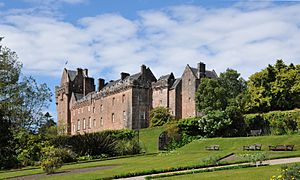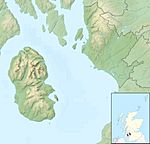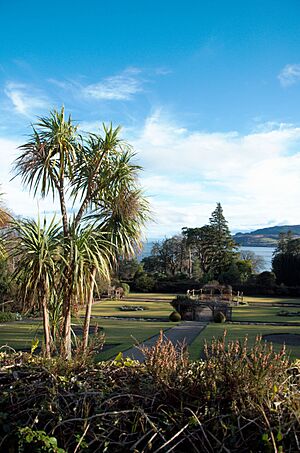Brodick Castle facts for kids
Quick facts for kids Brodick Castle |
|
|---|---|
| Outside Brodick, Isle of Arran, Scotland | |

Brodick Castle (June 2013)
|
|
| Coordinates | 55°35′38″N 5°09′04″W / 55.5940°N 5.1511°W |
| Type | Tower house |
| Site information | |
| Owner | National Trust for Scotland |
| Controlled by | Dukes of Hamilton |
| Open to the public |
Yes |
| Condition | Preserved |
| Site history | |
| Built | 1510 (site since c.400) |
| Built by | Earl of Arran |
| In use | Until 1958 |
Brodick Castle is an amazing old castle located near the port of Brodick on the Isle of Arran, a beautiful island in Scotland. For a long time, it was the home of the powerful Dukes of Hamilton. Today, the National Trust for Scotland takes care of it. The castle is a very important historical building, and its gardens are also famous.
Contents
Exploring Brodick Castle's Past
Ancient Times: From Gaels to Vikings
People have lived and built forts on this spot for a very long time. As far back as the 400s, Gaelic people from Ireland came here. They expanded their kingdom called Dál Riata.
By the 900s, Vikings had a lot of influence. Arran became part of their lands called Súðreyjar. These lands were ruled from places like Dublin or Orkney. Brodick itself gets its name from the Norse word Breiðvík, meaning "Broad Bay." This shows how important the castle's location was. It was a key spot on the Firth of Clyde.
In the mid-1200s, Arran was part of the Kingdom of Mann and the Isles. This kingdom was ruled by two kings who were part Norse and part Gaelic. They were under the control of King Hákon IV of Norway. Alexander III of Scotland wanted to control these islands. He tried many times to take them over.
In 1262, the Earl of Ross attacked the island of Skye. King Hákon decided to get revenge. In July 1263, he sailed a large fleet to Scotland. His ships met up with other fleets and showed their strength. They anchored in Lamlash Bay on Arran. Scottish messengers tried to talk to King Hákon, but they failed.
A big battle happened at Largs, just across the water. The Scottish forces won this battle. King Hákon's forces went back to Arran. Then they sailed to Orkney for the winter, where King Hákon sadly died. In 1266, the Treaty of Perth was signed. This agreement gave the islands, including Arran, to the Kingdom of Scotland.
Wars for Scottish Independence
After King Alexander III and his granddaughter, Margaret, Maid of Norway, both died, Scotland faced a lot of trouble. In 1291, Edward I of England was asked to help choose the next Scottish king. John de Balliol was chosen. But he had to agree that Edward was his overlord.
In 1295, John de Balliol stood up to Edward. He refused to help Edward in a war in France. The next year, Edward invaded Scotland. He forced John to give up his crown. Around this time, English soldiers were stationed at Brodick Castle.
During this period, Robert the Bruce was hiding from the English. He had been crowned King of Scots but was defeated in battle. It's said that he had his famous encounter with a spider on Arran. This story taught him to never give up.
In the winter of 1306-1307, Robert the Bruce sent James Douglas, Lord of Douglas, to attack the English forces supplying Brodick Castle. This was a small but important victory. It helped Bruce's army get much-needed supplies. In January 1307, Douglas and Sir Robert Boyd of Kilmarnock successfully took Brodick Castle from the English. It was one of the first castles Bruce's forces recaptured in their fight for Scotland's freedom.
Later Medieval Times
In 1406, Brodick Castle was badly damaged by an English force. They sailed into Brodick Bay and attacked. More destruction happened in 1455. This time, John of Islay, the Lord of the Isles, caused the damage.
After 1470, King James III gave the castle to his brother-in-law, James Hamilton, 1st Lord Hamilton. His son, James Hamilton, became the Earl of Arran in 1503. The Hamilton family then added a special ship symbol, called a Lymphad, to their family crest. This symbol represented their connection to the Isles.
The Hamilton Family at Brodick
The Earls of Arran
The Earl of Arran rebuilt the castle by 1510. It became a strong tower house. But it still faced attacks from other powerful families.
During a time known as the "Rough Wooing," Brodick Castle was attacked again. This was when King Henry VIII of England wanted Mary, Queen of Scots, to marry his son. The English force was led by the Earl of Lennox. This attack was revenge for the actions of the 2nd Earl of Arran.
Lord Arran was the Regent of Scotland. This meant he ruled Scotland while Mary was a baby. He was also second in line to the Scottish throne. In 1543, he helped arrange for Mary to marry the Dauphin of France. She had previously been promised to Henry VIII's son. Lord Arran was rewarded for his efforts. He was given the title Duke of Châtellerault in France. During his time at Brodick, Regent Arran continued to make the castle bigger and stronger.
In the summer of 1550, workers like Andrew Hamilton and Dean John Slater helped build parts of the castle. In 1552, live partridges and hares were sent to Brodick for the Regent's meals. A special tool was bought to make holes for a rabbit warren. A carpenter named Peter Moffett made new doors. Some wood for the new building came from the Laird of Luss.
In May 1579, the Earl of Argyll took Brodick Castle for King James VI. Ninian Stewart was put in charge of the castle for the king. In 1602, Paul Hamilton, who was the captain of Brodick for the Marquess of Hamilton, attacked a farmer. He took the farmer's horse, cattle, wool, and plaids. He also imprisoned another man at Brodick.
The Dukes of Hamilton
Brodick Castle was also affected by the religious conflicts of the 1600s. Scotland was divided between two main Christian groups. One was the Presbyterians, and the other was the Episcopalians. King Charles I favored the Episcopalians.
James Hamilton, who was the King's advisor for Scotland, was sent north to make sure the King's wishes were followed. He had previously closed down the Scottish Church Assembly when they tried to get rid of bishops. Archibald Campbell, 1st Marquess of Argyll, was the leader of the Presbyterians in Scotland. Argyll took Hamilton's castle of Brodick.
Hamilton became a Duke in 1643. He got his castle back the next year when the Scottish Civil War began. But he lost it again to the Campbells in 1646. The Duke was captured after a big battle and was executed in March 1649.
His brother, William, became the next Duke. But he died from wounds received in battle in 1651. The title of Duke of Hamilton then passed to the first Duke's only surviving child, Anne. She had been sent to Brodick for safety. In 1650, Oliver Cromwell's soldiers, called Roundheads, took control of the castle. They made it bigger by building a special gun platform. This was to defend the Firth of Clyde.
Duchess Anne later moved back to her other estates. In 1656, she married William Douglas. Anne did not return to Brodick. However, her husband, who became the Duke of Hamilton for life, used the castle for hunting trips.
For many years, Brodick was mainly used as a place for hunting. In the 1800s, it became the home for the eldest son of the 10th Duke. This son was known as the Marquess of Douglas and Clydesdale.
William, the 11th Duke of Hamilton, married Princess Marie of Baden in 1843. She was the daughter of the Grand Duke of Baden. In 1844, huge building work began at the castle. The architect James Gillespie Graham almost tripled the size of the building.
The Twelfth Duke, William, had no sons. So, when he died, his titles went to a distant cousin. But he made sure the castle would go to his only daughter, Lady Mary Louise Douglas-Hamilton. She married the 6th Duke of Montrose in 1906. After more than 500 years, Brodick Castle was no longer owned by someone with the Hamilton name.
Brodick Castle Today
The National Trust for Scotland bought the castle and its gardens in 1958. They got it from Lady Jean Fforde. This happened after her mother, the Dowager Duchess of Montrose, passed away. Lady Jean later said that losing the castle was like losing her whole life. She had worked at Bletchley Park, a secret code-breaking center during World War II.
The castle is open to visitors during the summer months. The Brodick Country Park is open all year round. In 2019, over 68,000 people visited the site.
Inside the castle, you can see a copy of a famous engraving. It's by William Woollett and shows the painting The Death of General Wolfe by Benjamin West.
Since 1972, a picture of Brodick Castle has been on the back of twenty pound notes issued by the Royal Bank of Scotland. The 1998 movie The Governess, starring Minnie Driver, was filmed at Brodick Castle.
Castle Gardens
You can see special "bee boles" in the Walled Garden. These are small alcoves built into walls where beehives used to be kept. The Walled Garden itself was built in 1710.
See also
 In Spanish: Castillo de Brodick para niños
In Spanish: Castillo de Brodick para niños
- Banknotes of Scotland (featured on design)
- Home Farm, Brodick



